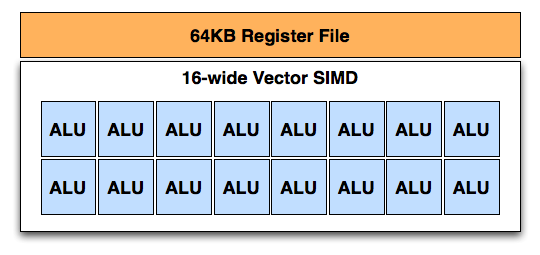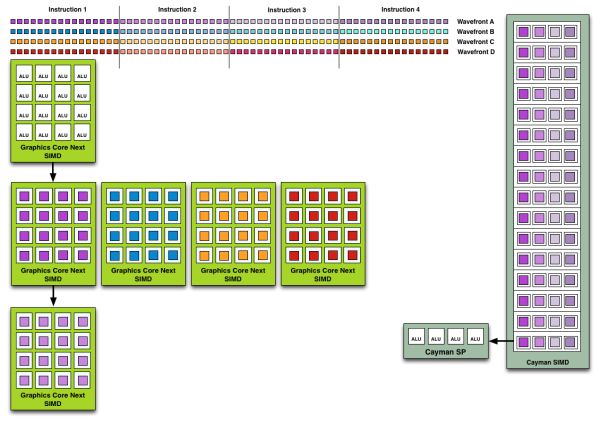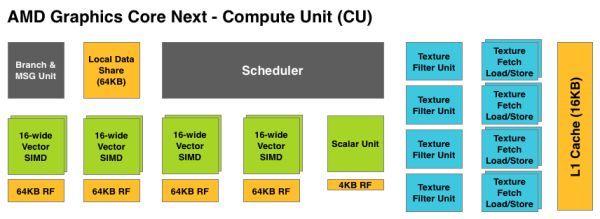AMD Radeon HD 7970 Review: 28nm And Graphics Core Next, Together As One
by Ryan Smith on December 22, 2011 12:00 AM EST- Posted in
- GPUs
- AMD
- Radeon
- ATI
- Radeon HD 7000
A Quick Refresher, Cont
Having established what’s bad about VLIW as a compute architecture, let’s discuss what makes a good compute architecture. The most fundamental aspect of compute is that developers want stable and predictable performance, something that VLIW didn’t lend itself to because it was dependency limited. Architectures that can’t work around dependencies will see their performance vary due to those dependencies. Consequently, if you want an architecture with stable performance that’s going to be good for compute workloads then you want an architecture that isn’t impacted by dependencies.
Ultimately dependencies and ILP go hand-in-hand. If you can extract ILP from a workload, then your architecture is by definition bursty. An architecture that can’t extract ILP may not be able to achieve the same level of peak performance, but it will not burst and hence it will be more consistent. This is the guiding principle behind NVIDIA’s Fermi architecture; GF100/GF110 have no ability to extract ILP, and developers love it for that reason.
So with those design goals in mind, let’s talk GCN.
VLIW is a traditional and well proven design for parallel processing. But it is not the only traditional and well proven design for parallel processing. For GCN AMD will be replacing VLIW with what’s fundamentally a Single Instruction Multiple Data (SIMD) vector architecture (note: technically VLIW is a subset of SIMD, but for the purposes of this refresher we’re considering them to be different).

A Single GCN SIMD
At the most fundamental level AMD is still using simple ALUs, just like Cayman before it. In GCN these ALUs are organized into a single SIMD unit, the smallest unit of work for GCN. A SIMD is composed of 16 of these ALUs, along with a 64KB register file for the SIMDs to keep data in.
Above the individual SIMD we have a Compute Unit, the smallest fully independent functional unit. A CU is composed of 4 SIMD units, a hardware scheduler, a branch unit, L1 cache, a local date share, 4 texture units (each with 4 texture fetch load/store units), and a special scalar unit. The scalar unit is responsible for all of the arithmetic operations the simple ALUs can’t do or won’t do efficiently, such as conditional statements (if/then) and transcendental operations.
Because the smallest unit of work is the SIMD and a CU has 4 SIMDs, a CU works on 4 different wavefronts at once. As wavefronts are still 64 operations wide, each cycle a SIMD will complete ¼ of the operations on their respective wavefront, and after 4 cycles the current instruction for the active wavefront is completed.
Cayman by comparison would attempt to execute multiple instructions from the same wavefront in parallel, rather than executing a single instruction from multiple wavefronts. This is where Cayman got bursty – if the instructions were in any way dependent, Cayman would have to let some of its ALUs go idle. GCN on the other hand does not face this issue, because each SIMD handles single instructions from different wavefronts they are in no way attempting to take advantage of ILP, and their performance will be very consistent.

Wavefront Execution Example: SIMD vs. VLIW. Not To Scale - Wavefront Size 16
There are other aspects of GCN that influence its performance – the scalar unit plays a huge part – but in comparison to Cayman, this is the single biggest difference. By not taking advantage of ILP, but instead taking advantage of Thread Level Parallism (TLP) in the form of executing more wavefronts at once, GCN will be able to deliver high compute performance and to do so consistently.
Bringing this all together, to make a complete GPU a number of these GCN CUs will be combined with the rest of the parts we’re accustomed to seeing on a GPU. A frontend is responsible for feeding the GPU, as it contains both the command processors (ACEs) responsible for feeding the CUs and the geometry engines responsible for geometry setup. Meanwhile coming after the CUs will be the ROPs that handle the actual render operations, the L2 cache, the memory controllers, and the various fixed function controllers such as the display controllers, PCIe bus controllers, Universal Video Decoder, and Video Codec Engine.
At the end of the day if AMD has done their homework GCN should significantly improve compute performance relative to VLIW4 while gaming performance should be just as good. Gaming shader operations will execute across the CUs in a much different manner than they did across VLIW, but they should do so at a similar speed. And for games that use compute shaders, they should directly benefit from the compute improvements. It’s by building out a GPU in this manner that AMD can make an architecture that’s significantly better at compute without sacrificing gaming performance, and this is why the resulting GCN architecture is balanced for both compute and graphics.












292 Comments
View All Comments
CeriseCogburn - Sunday, March 11, 2012 - link
We'll have to see if amd "magically changes that number and informs Anand it was wrong like they did concerning their failed recent cpu.... LOLThat's a whole YEAR of lying to everyone trying to make their cpu look better than it's actual fail, and Anand shamefully chose to announce the number change "with no explanation given by amd"... -
That's why you should be cautious - we might find out the transistor count is really 33% different a year from now.
piroroadkill - Thursday, December 22, 2011 - link
Only disappointing if you:a) ignored the entire review
b) looked at only the chart for noise
c) have brain damage
Finally - Thursday, December 22, 2011 - link
In Eyefinity setups the new generation shines: http://tinyurl.com/bu3wb5cwicko - Thursday, December 22, 2011 - link
I think the price is disappointing. Everything else is nice though.CeriseCogburn - Sunday, March 11, 2012 - link
The drivers suckRussianSensation - Thursday, December 22, 2011 - link
Not necessarily. The other possibility is that being 37% better on average at 1080P (from this Review) over HD6970 for $320 more than an HD6950 2GB that can unlock into a 6970 just isn't impressive enough. That should be d).piroroadkill - Friday, December 23, 2011 - link
Well, I of course have a 6950 2GB that unlocked, so as far as I'm concerned, that has been THE choice since the launch of the 6950, and still is today.But you have to ignore cost at launch, it's always high.
CeriseCogburn - Thursday, March 8, 2012 - link
I agree RS, as these amd people are constantly screaming price percentage increase vs performance increase... yet suddenly applying the exact combo they use as a weapon against Nvidia to themselves is forbidden, frowned upon, discounted, and called unfair....Worse yet, according to the same its' all Nvidia's fault now - that amd is overpriced through the roof...LOL - I have to laugh.
Also, the image quality page in the review was so biased toward amd that I thought I was going to puke.
Amd is geven credit for a "perfect algorythm" that this very website has often and for quite some time declared makes absolutely no real world difference in games - and in fact, this very reviewer admitted the 1+ year long amd failure in this area as soon as they released "the fix" - yet argued everyone else was wrong for the prior year.
The same thing appears here.
Today we find out the GTX580 nvidia card has much superior anti-shimmering than all prior amd cards, and that finally, the 7000 high end driver has addressed the terrible amd shimmering....
Worse yet, the decrepit amd low quality impaired screens are allowed in every bench, with the 10% amd performance cheat this very site outlined them merely stated we hope Nvidia doesn't so this too - then allowed it, since that year plus ago...
In the case of all the above, I certainly hope the high end 797x cards aren't CHEATING LIKE HECK still.
For cripe sakes, get the AA stuff going, stop the 10% IQ cheating, and get our bullet physics or pay for PhysX, and stabilize the drivers .... I am sick of seeing praise for cheating and failures - if they are (amd) so great let's GET IT UP TO EQUIVALENCY !
Wow I'm so mad I don't have a 7970 as supply is short and I want to believe in amd for once... FOR THE LOVE OF GOD DID THEY GET IT RIGHT THIS TIME ?!!?
slayernine - Thursday, December 22, 2011 - link
Holy fan boys batman!This comment thread reeks of nvidia fans green with jealousy
Hauk - Thursday, December 22, 2011 - link
LOL, Wreckage first!Love him or hate him, he's got style..